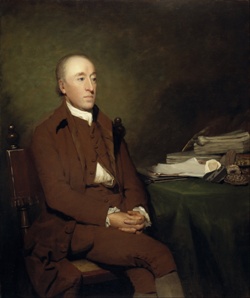Geologist and science writer Nina Morgan discovers what James Hutton got up to in his spare time
 Image:
Image: James Hutton as painted by Sir Henry Raeburn in 1776.
As the geologist and polymath, James Hutton (1726-1797) might have put it, when it comes to home brewing – there really is no vestige of a beginning, and no prospect of an end to the ingredients that can be used. It is possible to ferment almost any vegetable or fruit – though whether you'd actually want to drink the resulting product is another matter. The same might be said about Hutton's own written output.
A frequent contributor to the Transactions of the Royal Society of Edinburgh, Hutton wrote – at length – on topics ranging from philosophy to rain, language and speech, and much else in between, and earned a reputation for producing dense, dull prose at inordinate length. His Theory of the Earth, first published in four lengthy parts in 1785 in the Transactions, is a case in point. Although it contains many important insights about unconformities and deep time – ideas that revolutionised geological thinking and formed the basis of the concept of uniformitarianism discussed in such influential books such as Lyell's Principles of Geology,(published in 3 volumes between 1830 and 1833)— Hutton's ground-breaking concepts may never have come to light had not his colleague, John Playfair (1748-1819), Professor of Natural History at the University of Edinburgh, recognised their importance and taken the trouble to present them in a more readable and understandable form.
In 1822, in Volume IV of his own collected works, Playfair also provided an 88-page Biographical Account of the Late James Hutton, MD. In this he not only waxed lyrical about Hutton's work. He also revealed a bit about Hutton's passion for natural history in general, and geology in particular, and provided insights into Hutton's private life:
"...Though he [Hutton] used to rise late, he began immediately to study, and generally continued busy till dinner. He dined early, almost always at home, and passed very little time at table; for he ate sparingly and drank no wine."
But Hutton apparently was not adverse to dabbling in spirits. In 1788, he teamed up with his close friend, physician and chemist Joseph Black (1728-1799), and with James Russell (1754-1836, a Fellow of the Royal College of Surgeons in Edinburgh) to report on a process for producing 'an ardent spirit from carrots'. Presumably a lot of tasting of the product was required to ensure quality control. But for Hutton, it must have been only in the name of scientific enquiry, of course!
Acknowledgement
The starting point for this vignette was the article James Hutton Meteorologist, Geologist, Phonetician and Carrot Brandy Expert by G Y Craig, published in issue 8 July 1997 issue of Earth Heritage. Other sources include Volume 1 of the Transactions of the Royal Society of Edinburgh, available on-line at http://biodiversitylibrary.org/, which includes an account of the carrot brandy experiments (pp.28-29); as well as all four parts of Hutton's Theory of the Earth. Further biographical information was taken from entries in Wikipedia, Dictionary of National Biography and http://www.electricscotland.com.
- If the past is the key to your present interests, why not join the History of Geology Group (HOGG). For more information and to read the latest HOGG Newsletter, visit www.historyofgeologygroup.co.uk.
*Nina Morgan is a geologist and science writer based near Oxford.